 W
WAir pollution is the presence of substances in the atmosphere that are harmful to the health of humans and other living beings, or cause damage to the climate or to materials. There are different types of air pollutants, such as gases, particulates, and biological molecules. Air pollution may cause diseases, allergies and even death to humans; it may also cause harm to other living organisms such as animals and food crops, and may damage the natural or built environment. Both human activity and natural processes can generate air pollution.
 W
WThe Aarhus Protocol on Persistent Organic Pollutants, a 1998 protocol on persistent organic pollutants (POPs), is an addition to the 1979 Geneva Convention on Long-Range Transboundary Air Pollution (LRTAP). The Protocol seeks "to control, reduce or eliminate discharge, emissions and losses of persistent organic pollutants" in Europe, some former Soviet Union countries, and the United States, in order to reduce their transboundary fluxes so as to protect human health and the environment from adverse effects.
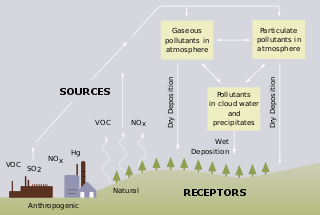 W
WAcid rain is a rain or any other form of precipitation that is unusually acidic, meaning that it has elevated levels of hydrogen ions. It can have harmful effects on plants, aquatic animals, and infrastructure. Acid rain is caused by emissions of sulfur dioxide and nitrogen oxide, which react with the water molecules in the atmosphere to produce acids. Some governments have made efforts since the 1970s to reduce the release of sulfur dioxide and nitrogen oxide into the atmosphere with positive results. Nitrogen oxides can also be produced naturally by lightning strikes, and sulfur dioxide is produced by volcanic eruptions. Acid rain has been shown to have adverse impacts on forests, freshwaters, and soils, killing insect and aquatic life-forms, causing paint to peel, corrosion of steel structures such as bridges, and weathering of stone buildings and statues as well as having impacts on human health.
 W
WAir pollutant concentrations, as measured or as calculated by air pollution dispersion modeling, must often be converted or corrected to be expressed as required by the regulations issued by various governmental agencies. Regulations that define and limit the concentration of pollutants in the ambient air or in gaseous emissions to the ambient air are issued by various national and state environmental protection and occupational health and safety agencies.
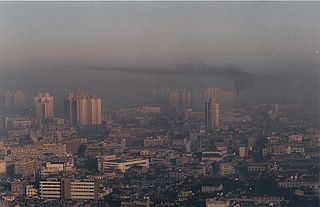 W
WAn air quality index (AQI) is used by government agencies to communicate to the public how polluted the air currently is or how polluted it is forecast to become. Public health risks increase as the AQI rises. Different countries have their own air quality indices, corresponding to different national air quality standards. Some of these are the Air Quality Health Index (Canada), the Air Pollution Index (Malaysia), and the Pollutant Standards Index (Singapore).
 W
WAir quality laws govern the emission of air pollutants into the atmosphere. A specialized subset of air quality laws regulate the quality of air inside buildings. Air quality laws are often designed specifically to protect human health by limiting or eliminating airborne pollutant concentrations. Other initiatives are designed to address broader ecological problems, such as limitations on chemicals that affect the ozone layer, and emissions trading programs to address acid rain or climate change. Regulatory efforts include identifying and categorizing air pollutants, setting limits on acceptable emissions levels, and dictating necessary or appropriate mitigation technologies.
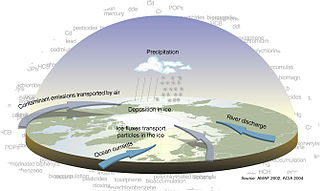 W
WArctic haze is the phenomenon of a visible reddish-brown springtime haze in the atmosphere at high latitudes in the Arctic due to anthropogenic air pollution. A major distinguishing factor of Arctic haze is the ability of its chemical ingredients to persist in the atmosphere for significantly longer than other pollutants. Due to limited amounts of snow, rain, or turbulent air to displace pollutants from the polar air mass in spring, Arctic haze can linger for more than a month in the northern atmosphere.
 W
WAtmospheric dispersion modeling is the mathematical simulation of how air pollutants disperse in the ambient atmosphere. It is performed with computer programs that include algorithms to solve the mathematical equations that govern the pollutant dispersion. The dispersion models are used to estimate the downwind ambient concentration of air pollutants or toxins emitted from sources such as industrial plants, vehicular traffic or accidental chemical releases. They can also be used to predict future concentrations under specific scenarios. Therefore, they are the dominant type of model used in air quality policy making. They are most useful for pollutants that are dispersed over large distances and that may react in the atmosphere. For pollutants that have a very high spatio-temporal variability and for epidemiological studies statistical land-use regression models are also used.
 W
WThe environmental impact of aviation occurs because aircraft engines emit heat, noise, particulates and gases. Like other emissions resulting from fossil fuel combustion, aircraft engines produce emissions, rising environmental concerns over their global impact and their local air quality effect. Airplanes emit gases and atmospheric particulates, interacting among themselves and with the atmosphere. While the aviation industry is more efficient, halving the amount of fuel burned per flight compared to 1990 through technological advancement and operations improvements, overall emissions have risen as the volume of air travel has increased.
 W
WBeta attenuation monitoring (BAM) is a widely used air monitoring technique employing the absorption of beta radiation by solid particles extracted from air flow. This technique allows for the detection of PM10 and PM2.5, which are monitored by most air pollution regulatory agencies. The main principle is based on a kind of Bouguer (Lambert–Beer) law: the amount by which the flow of beta radiation (electrons) is attenuated by a solid matter is exponentially dependent on its mass and not on any other feature (such as density, chemical composition or some optical or electrical properties) of this matter. So, the air is drawn from outside of the detector through an "infinite" (cycling) ribbon made from some filtering material so that the particles are collected on it. There are two sources of beta radiation placed one before and one after the region where air flow passes through the ribbon leaving particles on it; and there are also two detectors on the opposite side of the ribbon, facing the detectors. The sources' intensity and detectors' sensitivity being the same (or corrected with appropriate calibration lookup table), the intensity of beta rays detected by one of detectors is compared to that of the other. Thus one can deduce how much mass has the ribbon acquired upon being exposed to air flow; knowing the drain velocity, actual particle mass concentration in air could be assessed.
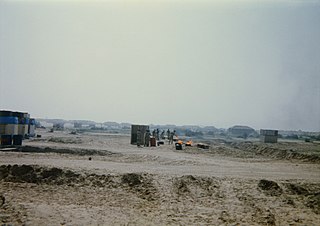 W
WA burn pit refers to an area of a deployed military base devoted to open-air combustion of waste. The phrase "burn pit" gained notoriety in the 21st century, especially in U.S. military sites in Iraq and Afghanistan. However, this practice was used well before the War on Terror. Proper waste management practices have reduced the spread of infectious diseases that contributed significantly to mortality and morbidity in military populations in based conflicts. According to the US Army field manual, there are four other ways, outside of burn pits, to dispose of nonhazardous solid waste: incinerators, burial, landfills, and tactical burial. Using open-air burning significantly reduces waste, but increases risk of fire and produces noxious fumes. Due to modern waste in deployed environments, there is plastic, shipping materials, electronic waste, and other material that may emit toxic aerial compounds. Burn pits were heavily criticized and resulted in lawsuit by veterans, Department of Defense Civilians, and military contractors. Global environmental consciousness has especially criticized these instances of large-scale burn pit operation. The effects of burn pits seem to be similar to that of fire debris cleanup.
 W
WA condensation particle counter or CPC is a particle counter that detects and counts aerosol particles by first enlarging them by using the particles as nucleation centers to create droplets in a supersaturated gas.
 W
WThe Czech Hydrometeorological Institute (CHMI) is within the Environmental Ministry of the Czech Republic. The head office and centralized workplaces of the CHMI, including the data processing, telecommunication and technical services, are located at the Institute's own campus in Prague.
 W
WThe Decipol is a unit used to measure the perceived air quality. It was introduced by Danish professor P. Ole Fanger.
 W
WDiesel exhaust is the gaseous exhaust produced by a diesel type of internal combustion engine, plus any contained particulates. Its composition may vary with the fuel type or rate of consumption, or speed of engine operation, and whether the engine is in an on-road vehicle, farm vehicle, locomotive, marine vessel, or stationary generator or other application.
 W
WDust abatement refers to the process of inhibiting the creation of excess soil dust, a pollutant that contributes to excess levels of particulate matter.
 W
WSince the start of the twentieth century, the role of the car has become highly important though controversial. It is used throughout the world and has become the most popular mode of transport in the more developed countries. In developing countries, the effects of the car on society are not as visible, however they are significant. The development of the car built upon the transport sector first started by railways. This has introduced sweeping changes in employment patterns, social interactions, infrastructure and the distribution of goods.
 W
WEmission standards are the legal requirements governing air pollutants released into the atmosphere. Emission standards set quantitative limits on the permissible amount of specific air pollutants that may be released from specific sources over specific timeframes. They are generally designed to achieve air quality standards and to protect human life. Different regions and countries have different standards for vehicle emissions.
 W
WExhaust gas or flue gas is emitted as a result of the combustion of fuels such as natural gas, gasoline (petrol), diesel fuel, fuel oil, biodiesel blends, or coal. According to the type of engine, it is discharged into the atmosphere through an exhaust pipe, flue gas stack, or propelling nozzle. It often disperses downwind in a pattern called an exhaust plume.
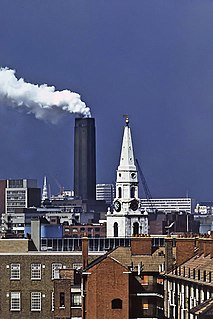 W
WFlue gas is the gas exiting to the atmosphere via a flue, which is a pipe or channel for conveying exhaust gases from a fireplace, oven, furnace, boiler or steam generator. Quite often, the flue gas refers to the combustion exhaust gas produced at power plants. Its composition depends on what is being burned, but it will usually consist of mostly nitrogen derived from the combustion of air, carbon dioxide, and water vapor as well as excess oxygen. It further contains a small percentage of a number of pollutants, such as particulate matter, carbon monoxide, nitrogen oxides, and sulfur oxides.
 W
WFlue-gas desulfurization (FGD) is a set of technologies used to remove sulfur dioxide from exhaust flue gases of fossil-fuel power plants, and from the emissions of other sulfur oxide emitting processes such as waste incineration.
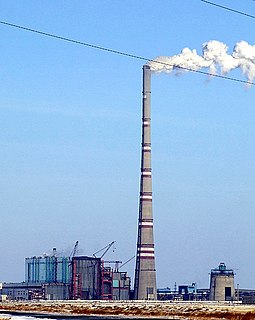 W
WA flue-gas stack, also known as a smoke stack, chimney stack or simply as a stack, is a type of chimney, a vertical pipe, channel or similar structure through which combustion product gases called flue gases are exhausted to the outside air. Flue gases are produced when coal, oil, natural gas, wood or any other fuel is combusted in an industrial furnace, a power plant's steam-generating boiler, or other large combustion device. Flue gas is usually composed of carbon dioxide (CO2) and water vapor as well as nitrogen and excess oxygen remaining from the intake combustion air. It also contains a small percentage of pollutants such as particulate matter, carbon monoxide, nitrogen oxides and sulfur oxides. The flue gas stacks are often quite tall, up to 400 metres (1300 feet) or more, so as to disperse the exhaust pollutants over a greater area and thereby reduce the concentration of the pollutants to the levels required by governmental environmental policy and environmental regulation.
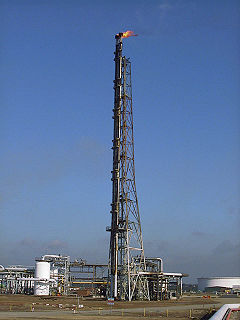 W
WA gas flare, alternatively known as a flare stack, is a gas combustion device used in industrial plants such as petroleum refineries, chemical plants and natural gas processing plants. They are also common at oil or gas extraction sites having oil wells, gas wells, offshore oil and gas rigs and landfills.
 W
WGlobal Emissions InitiAtive (GEIA) is a community effort dedicated to atmospheric emissions information exchange and competence building. GEIA was created in 1990 under the (IGBP) and is a joint IGAC / iLEAPS / AIMES activity. GEIA is governed by an international steering committee and hosts biennial conferences.
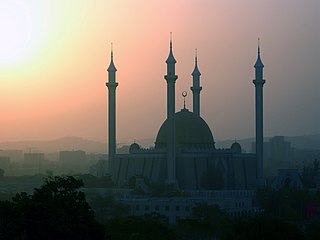 W
WHaze is traditionally an atmospheric phenomenon in which dust, smoke, and other dry particulates obscure the clarity of the sky. The World Meteorological Organization manual of codes includes a classification of horizontal obscuration into categories of fog, ice fog, steam fog, mist, haze, smoke, volcanic ash, dust, sand, and snow. Sources for haze particles include farming, traffic, industry, and wildfires.
 W
W1-Hydroxypyrene is a human metabolite. It can be found in urine of outdoor workers exposed to air pollution.
 W
WIndoor air quality (IAQ) is the air quality within and around buildings and structures. IAQ is known to affect the health, comfort, and well-being of building occupants. Poor indoor air quality has been linked to sick building syndrome, reduced productivity, and impaired learning in schools.
 W
WThe Indoor Environmental Quality Global Alliance (IEQ-GA) was initiated in 2014 aiming to improve the actual, delivered indoor environmental quality in buildings through coordination, education, outreach and advocacy. The alliance works to supply information, guidelines and knowledge on the indoor environmental quality (IEQ) in buildings and workplaces, and to provide occupants in buildings and workplaces with an acceptable indoor environmental quality and help promote implementation in practice of knowledge from research on the field.
 W
WLaze is acid rain and air pollution arising from steam explosions and large plume clouds containing extremely acidic condensate, which occur when molten lava flows enter cold oceans. The term laze is a portmanteau of lava and haze.
 W
WA line source, as opposed to a point source, area source, or volume source, is a source of air, noise, water contamination or electromagnetic radiation that emanates from a linear (one-dimensional) geometry. The most prominent linear sources are roadway air pollution, aircraft air emissions, roadway noise, certain types of water pollution sources that emanate over a range of river extent rather than from a discrete point, elongated light tubes, certain dose models in medical physics and electromagnetic antennas. While point sources of pollution were studied since the late nineteenth century, linear sources did not receive much attention from scientists until the late 1960s, when environmental regulations for highways and airports began to emerge. At the same time, computers with the processing power to accommodate the data processing needs of the computer models required to tackle these one-dimensional sources became more available.
 W
WA low-emission zone (LEZ) is a defined area where access by some polluting vehicles is restricted or deterred with the aim of improving air quality. This may favour vehicles such as (certain) alternative fuel vehicles, hybrid electric vehicles, plug-in hybrids, and zero-emission vehicles such as all-electric vehicles.
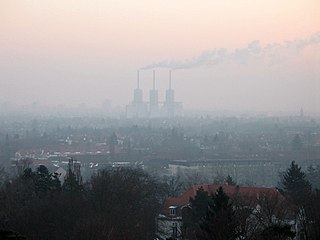 W
WMist is a phenomenon caused by small droplets of water suspended in air. Physically, it is an example of a dispersion. It is most commonly seen where warm, moist air meets sudden cooling, such as in exhaled air in the winter, or when throwing water onto the hot stove of a sauna. It can be created artificially with aerosol canisters if the humidity and temperature conditions are right. It can also occur as part of natural weather, when humid air cools rapidly, for example when the air comes into contact with surfaces that are much cooler than the air.
 W
WMobile source air pollution includes any air pollution emitted by motor vehicles, airplanes, locomotives, and other engines and equipment that can be moved from one location to another. Many of these pollutants contribute to environmental degradation and have negative effects on human health. To prevent unnecessary damage to human health and the environment, environmental regulatory agencies such as the U.S. Environmental Protection Agency have established policies to minimize air pollution from mobile sources. Similar agencies exist at the state level. Due to the large number of mobile sources of air pollution, and their ability to move from one location to another, mobile sources are regulated differently from stationary sources, such as power plants. Instead of monitoring individual emitters, such as an individual vehicle, mobile sources are often regulated more broadly through design and fuel standards. Examples of this include corporate average fuel economy standards and laws that ban leaded gasoline in the United States. The increase in the number of motor vehicles driven in the U.S. has made efforts to limit mobile source pollution challenging. As a result, there have been a number of different regulatory instruments implemented to reach the desired emissions goals.
 W
WThe National Air Pollution Symposium was held on November 10–11, 1949 in Pasadena, California by the Stanford Research Institute, along with assistance from the California Institute of Technology, the University of Southern California and the University of California.
 W
WNew car smell is the odor that comes from the combination of materials found in new automobiles, as well as other vehicles like buses or trucks. Although the scent is described as pleasant by some, there is some question about the possibility that these chemicals pose a health risk.
 W
WThe NIOSH air filtration rating is the U.S. National Institute for Occupational Safety and Health (NIOSH)'s classification of filtering respirators. The ratings describe the ability of the device to protect the wearer from dust and liquid droplets in the air. The certification and approval process for respiratory protective devices is governed by Part 84 of Title 42 of the Code of Federal Regulations. Respiratory protective devices so classified include air-purifying respirators (APR) such as filtering facepiece respirators and chemical protective cartridges that have incorporated particulate filter elements.
 W
WThe Norwegian Institute for Air Research or NILU is one of the leading specialized scientific laboratories in Europe researching issues related to air pollution, climate change and health. It is an independent nonprofit institution, established in 1969, staffed by scientists, engineers and technicians with specialized expertise for working on air pollution problems. The staff do more than two hundred projects annually for research councils, industries, international banks and local, national and international authorities and organizations. Its director since 2009 is Kari Nygaard.
 W
WThe PM NowCast is a weighted average of hourly air monitoring data used by the United States Environmental Protection Agency (USEPA) for real-time reporting of the Air Quality Index (AQI) for PM (PM10 or PM2.5).
 W
WParticulates – also known as atmospheric aerosol particles, atmospheric particulate matter, particulate matter (PM), or suspended particulate matter (SPM) – are microscopic particles of solid or liquid matter suspended in the air. The term aerosol commonly refers to the particulate/air mixture, as opposed to the particulate matter alone. Sources of particulate matter can be natural or anthropogenic. They have impacts on climate and precipitation that adversely affect human health, in ways additional to direct inhalation.
 W
WThe Partnership for a New Generation of Vehicles was a cooperative research program between the U.S. government and the three major domestic auto corporations, aimed at bringing extremely fuel-efficient (up to 80 mpg‑US vehicles to market by 2003.
 W
WPassive smoking is the inhalation of smoke, called secondhand smoke (SHS), or environmental tobacco smoke (ETS), by persons other than the intended "active" smoker. It occurs when tobacco smoke enters an environment, causing its inhalation by people within that environment. Exposure to secondhand tobacco smoke causes disease, disability, and death. The health risks of secondhand smoke are a matter of scientific consensus. These risks have been a major motivation for smoke-free laws in workplaces and indoor public places, including restaurants, bars and night clubs, as well as some open public spaces.
 W
WA photoinitiator is a molecule that creates reactive species when exposed to radiation. Synthetic photoinitiators are key components in photopolymers.
 W
WA pollen count is the measurement of the number of grains of pollen in a cubic meter of air. High pollen counts can sometimes lead to increased rates of allergic reaction for those with allergic disorders. Usually, the counts are announced for specific plants such as grass, ash, or olive. These are tailored to common plants in the measured areas. Mild winters with warmer days lead to an increase in pollen counts while colder winters lead to delayed pollen release.
 W
WA regenerative thermal oxidizer (RTO) is a piece of industrial equipment used for the treatment of exhaust air. The system is a type of thermal oxidizer that uses a bed of ceramic material to absorb heat from the exhaust gas. It then uses this captured heat to preheat the incoming process gas stream and destroy air pollutants emitted from process exhaust streams at temperatures ranging from 815 °C to 980 °C
 W
WRoadway air dispersion modeling is the study of air pollutant transport from a roadway or other linear emitter. Computer models are required to conduct this analysis, because of the complex variables involved, including vehicle emissions, vehicle speed, meteorology, and terrain geometry. Line source dispersion has been studied since at least the 1960s, when the regulatory framework in the United States began requiring quantitative analysis of the air pollution consequences of major roadway and airport projects. By the early 1970s this subset of atmospheric dispersion models were being applied to real world cases of highway planning, even including some controversial court cases.
 W
WRolling coal is the practice of modifying a diesel engine to increase the amount of fuel entering the engine in order to emit large amounts of black or grey sooty exhaust fumes into the air. Rolling coal is sometimes used as a form of anti-environmentalism. Such modifications may include the intentional removal of the particulate filter. Practitioners often additionally modify their vehicles by installing smoke switches and smoke stacks. Modifications to a vehicle to enable rolling coal may cost from US$200 to US$5,000.
 W
WThe Twomey effect describes how additional cloud condensation nuclei (CCN), possibly from anthropogenic pollution, may increase the amount of solar radiation reflected by clouds. This is an indirect effect by such particles, as distinguished from direct effects (forcing) due to enhanced scattering or absorbing radiation by such particles not in clouds. Cloud droplets normally form on aerosol particles that serve as CCN. Increasing the number concentration of CCN can lead to formation of more cloud droplets, which, in turn, have smaller size.
 W
WDaniel A. Vallero is an American environmental author and scientist. He was born in East St. Louis, Illinois and grew up in Collinsville, Illinois. He received a bachelor's degree and a master's degree in city and regional planning from Southern Illinois University-Edwardsville. He also earned a masters in civil and environmental engineering from the University of Kansas and a PhD in civil and environmental engineering from Duke University with a thesis on "“Dicarboximide Fungicide Flux to the Lower Troposphere from an Aquic Hapludult Soil”
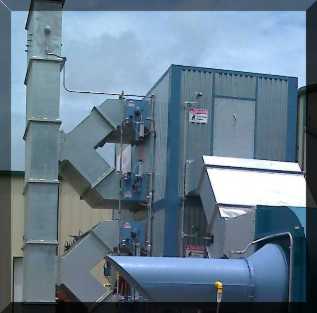 W
WVentilation air methane thermal oxidizers (or VAMTOX) are a type of processing equipment used for greenhouse gas abatement related to underground mining operations that destroys gaseous methane at a high temperature.
 W
WWildland fire and wildland fire atmospheric emissions have been a part of the global biosphere for millennia. The major wildland fire emissions include greenhouse gasses and several criteria pollutants that impact human health and welfare.: